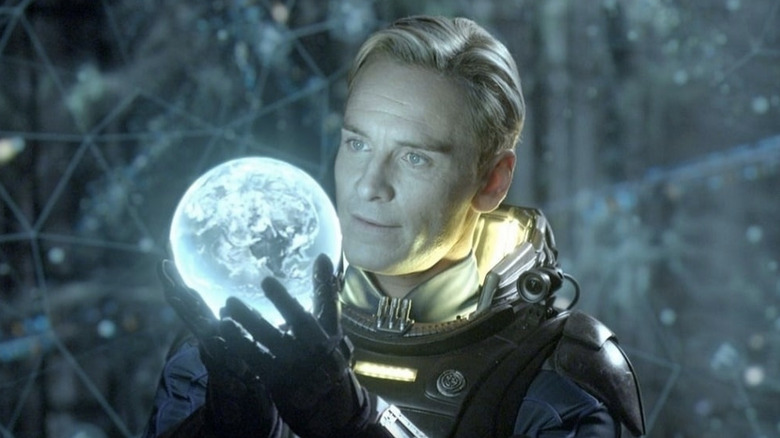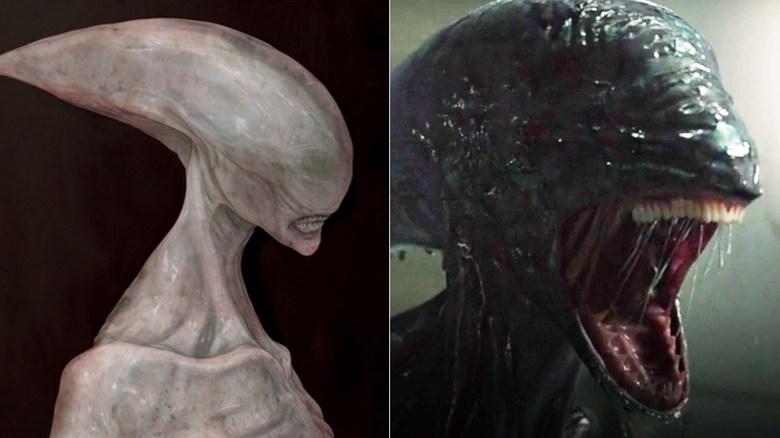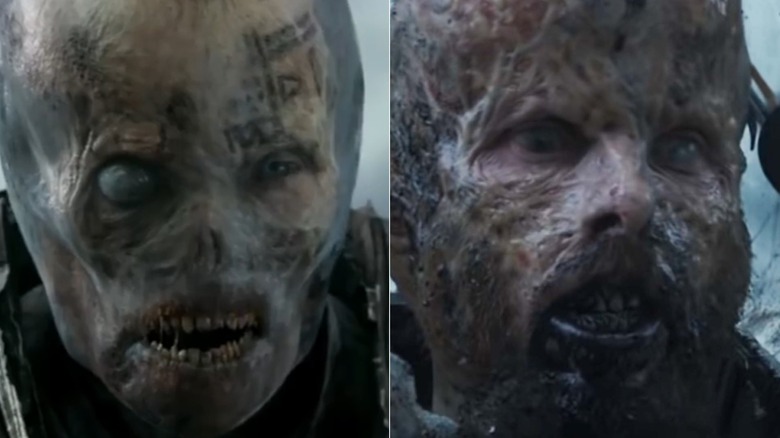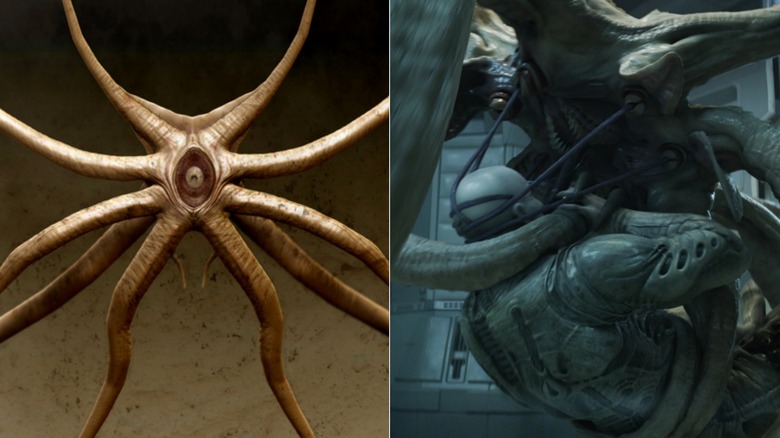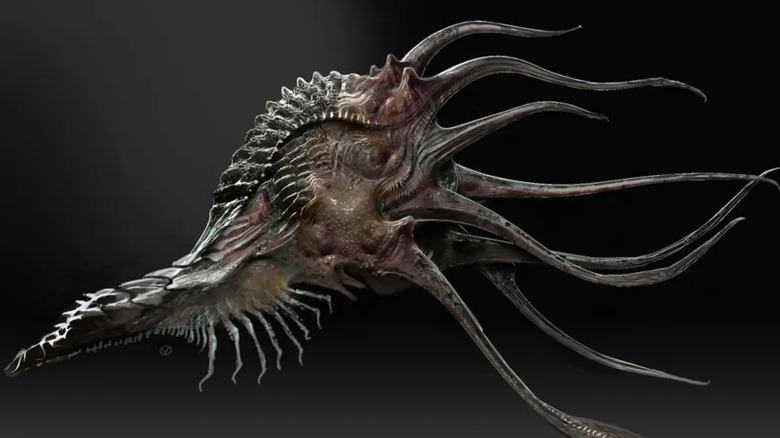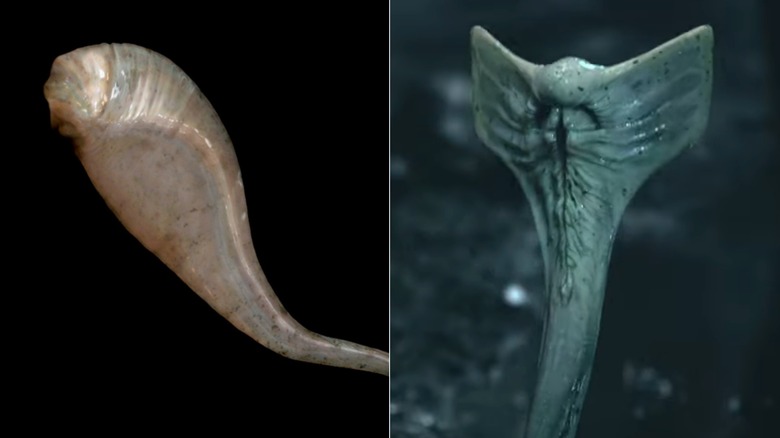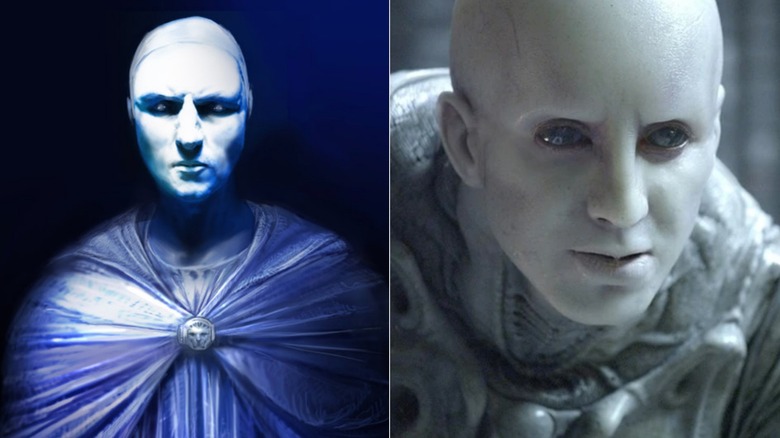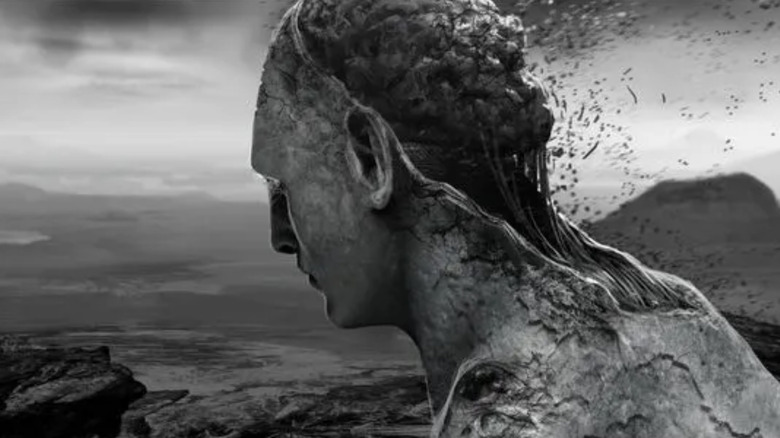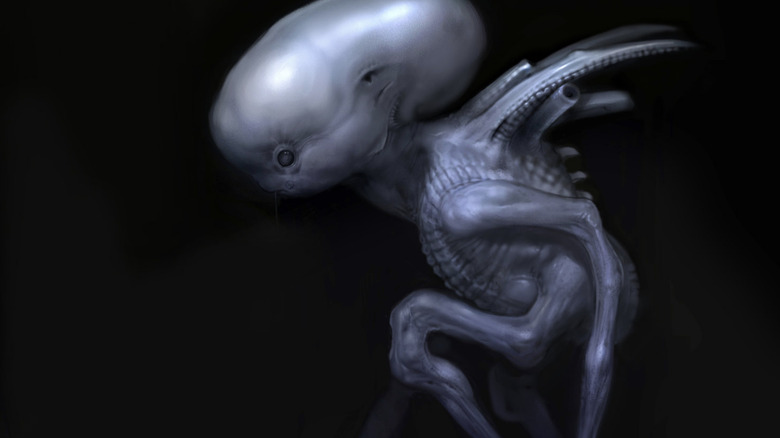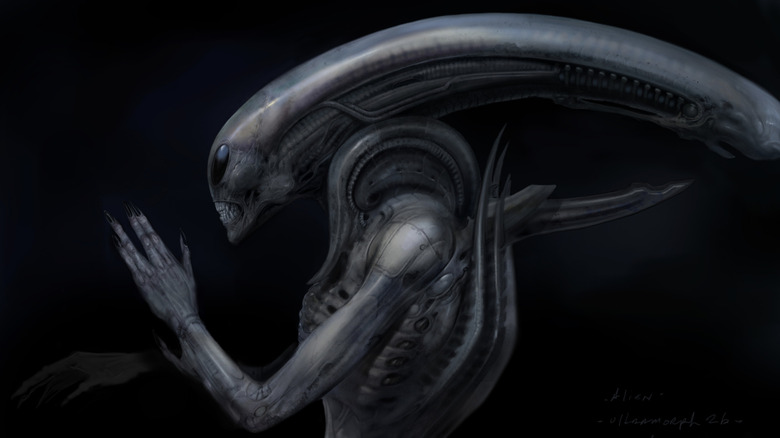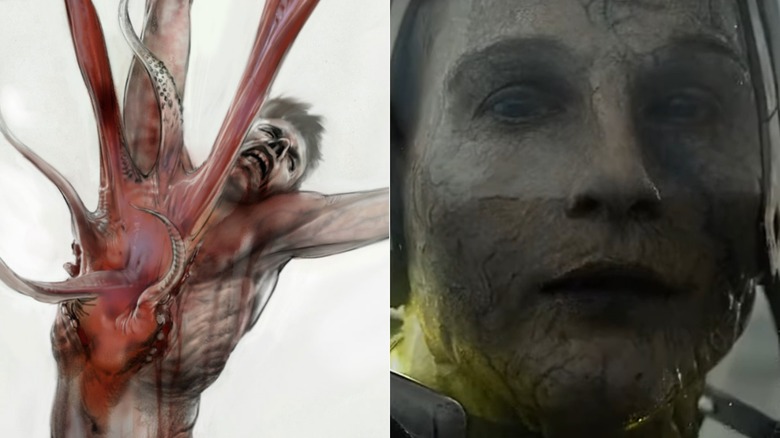The Alternate Designs For Prometheus' Aliens Are Even More Horrifying
It's been over a decade since Ridley Scott's original "Alien" prequel hit theaters, but after all these years, this philosophical science-fiction thriller still sticks with us. There are plenty of reasons to love "Prometheus" — which boasts an inspired cast, a compelling script, and thoughtful direction by Scott himself — but perhaps one of the biggest reasons is the new alien creatures brought to life on the big screen. Between uncovering the origins of the Xenomorphs to encountering new, deadly alien threats, this movie has it all. Later franchise installments like 2024's "Alien: Romulus" even gave "Prometheus" the respect it deserves by including major plot points from the 2012 picture in its own narrative.
But as we look through some of the initial concept art and creature designs by artists like Ivan Manzella, David Levy, and Carlos Huante, we can see that "Prometheus" could have been a lot more frightening. Of course, the original "Alien" is a space horror, and so the notion that a direct prequel would be anything less almost seems silly, but Scott's tonal shifts prove otherwise. From the get-go, we can see that "Prometheus" aspired to be more than just another "'Texas Chainsaw Massacre' in space," even if some interstellar terrors still peeked through. If you thought that the aliens we saw in this first prequel were bad, just wait until you see what they could have looked like.
The Deacon alien was less Xenomorph-like originally
At the very end of "Prometheus," when Elizabeth Shaw (Noomi Rapace) and David (Michael Fassbender) venture into the stars to discover why the Engineers wanted to destroy mankind, we cut back to the surface of LV-223. There, the dead Engineer's body thrusts and squirms until a living creature erupts from its chest cavity, making its way to the floor beside its dead host. After a moment, this alien stands tall on its own, and with a sleek, black-blue appearance, the monster opens its jaws to reveal a second set hidden in its throat. While most casual viewers probably thought this was nothing more than a younger Xenomorph, longtime "Alien" fans would come to know this creature by its given name, Deacon.
But originally, the Deacon alien wasn't as Xenomorph-ish as what we got in the final product. In concept designs by artist Ivan Manzella, we see that the Deacon alien was originally more humanoid in its appearance. Unlike the Xenomorphs fans have been familiar with since "Alien," the Deacon alien was bone-thin and initially didn't have a tail. Though different from a regular Xenomorph on the surface, the Deacon looked like a horrible demon creature that could just as easily tear you to pieces. Also unlike its final form, early drafts of this monster gave it a more translucent appearance, with a brighter creamy coloring closer to the Engineer it spawned from.
Fifield's transformation could've been a lot more gruesome
There's something truly frightening about the way that "Prometheus" introduces the dangers on LV-223. Though casual viewers might've thought that this was the same planet from the original "Alien," it's actually another world that the Engineers have messed with, producing a heap of different horrors for the Prometheus crew to tackle. After being sprayed by a Hammerpede's corrosive acid defense, geologist Sean Fifield (Sean Harris) is horribly disfigured and scarred by the incident. To make it worse, by the time he returns to the ship, he's become something of a monster himself and violently attacks his crewmates. But originally, Fifield's transformation was even scarier.
In a deleted variant of the "Fifield Mutation" scene, Fifield's shift from man to monster is more grotesque. Though the special effects are clearly not finished, we can see that he's lost his nose and seemingly the sight in one of his eyes. His whole face is more skeletal in appearance, which just adds to the terror as he jumps at his crewmates. Additionally, we can see that the alien creature's acid response also melted his helmet, which is collapsing in on his mutated face. Ivan Manzella's concept art takes this a step further, however, by adding additional distortions in his body shape and image, and also making him look a bit more alien-like than before. Though Fifield is just as hostile in either version of the scene, the character looks all the more horrific in his original design, more akin to a ghoul or zombie rather than a burn victim.
The Trilobite had even more tentacles than before
If you thought the Trilobite in "Prometheus" was horrific, then you should see what it looked like before. No doubt, the creature we see evolve on the Prometheus throughout the back half of the film is pretty terrifying. Between its seven large tentacles, four other smaller tendrils, and it's horrifically sharp teeth (clearly a proto-version of the first Facehugger from "Alien"), there's a lot to fear when it comes to this "Prometheus" monster. But in some of the original designs by concept artist Ivan Manzella, the Trilobite is even more deadly.
Though the creature would later take on a more starfish-shaped appearance, earlier versions of the alien monster came with 10 primary tentacles. While that might not seem like a big difference from seven, especially when the creature so easily disarms the giant Engineer, three more would certainly make this beast all the more formidable. Other versions of the Trilobite gave the creature a more spider-like appearance, with thin legs replacing the more octopus-like tentacles that the filmmakers settled on. Both versions are pretty grotesque, but what makes the concept art all the more intrusive is the revelation that the creature's vaginally-inspired orifice also contains a protruding reproductive tentacle of its own.
It also nearly had a rougher exterior
Interestingly enough, there was a point in the development phase where the Trilobite looked entirely different than the starfish-adjacent mammoth we saw on screen. If you thought this monster couldn't get any freakier, you'd be wrong. In one of David Levy's concept designs, the tentacled spectacle was a lot more rough around the edges. With an almost armored appearance, this creature would have had centipede-inspired legs protruding from its underbelly that would aid it in scurrying across the Prometheus's sterile floor. With eight massive tentacles still at the ready, this is one sci-fi monster we would not have wanted to tangle with.
Although this Trilobite design isn't bad, the final version as seen in "Prometheus" is much more in step with the general aesthetic of the film. Between the sleek spacecrafts and the Engineer's own sculpted features, it makes more sense that the "Alien" prequel would include monsters that feel cleaner and less busy in their design. Still, this version of the Trilobite would've given us nightmares, and would certainly have given its on-screen counterpart a run for its money.
The Hammerpedes looked more, well, sperm-like
Early on in "Prometheus," when the crew lands on LV-223, select members leave the ship to go exploring. While searching the monolithic structure left seemingly abandoned on the moon, biologist Millburn (Rafe Spall) and Fifield encounter a worm-like creature that stalks them in the water before making itself known. The snake-ish creature then interacts with the pair, and attacks Millburn as Fifield tries desperately to cut it off, resulting in his being sprayed with the alien's acidic blood. This ultimately leads to Fifield's aforementioned transformation, as well as Millburn's own demise. But before the creature attacks, it sprouts two appendages from the base of its head that earned it its nickname, Hammerpede.
Of course, the Hammerpede design went through a few different changes over the course of "Prometheus'" development and pre-production stages, with Ivan Manzella's own designs resembling an almost sperm-like appearance. This certainly falls in line with the reproductive themes of "Prometheus" and the "Alien" franchise in general, which has famously designed its trademark monsters with a phallic-like appearance (Fox once thought that H.R. Geiger's original designs were "too obscene" for "Alien"). In the end, the design was changed to what we know today as the Hammerpede creature, which looks less sperm-ish than its predecessor.
The Engineers originally had a more alien look
Ever since Ridley Scott's original "Alien" film hit theaters in 1979, fans have wondered at the identity of the "space jockey" found on LV-426. Well, although "Prometheus" takes us to LV-223, many of our questions were finally answered in Scott's official "Alien" prequel. Though there's a lot we still don't know about the Engineers (their whole reasoning for hating humanity is still confusing), we know that they're ultimately the ones responsible for the genetic experiments that the Prometheus crew are terrorized by throughout the film. But the marble-like appearance of the humanoid Engineers, clad in the space jockey flight suit, wasn't the only design constructed for these giant ancient aliens.
Concept artist Carlos Huante came up with a few different designs for the alien overlords, with some showing more elongated heads that resembled the Xenomorph creatures they'd come to create. Given the supposed connections made between the Engineers and humanity in the film, it does make sense that Scott ultimately went with a more humanoid appearance for his ancient aliens. But as far as creep factor is concerned, some of Huante's older designs would've made for an even more terrifying third act, with a more monster-like villain chasing our heroes. Thankfully, we were spared from a much spookier take on the Engineers.
The Engineers' sacrifice was a bit more brutal at first
Although Ridley Scott had settled on the Engineer design by the time concept artist David Levy began storyboarding the "Engineer sacrifice" scene, Levy's initial take on "Prometheus'" opening moments looked quite different from the final cut. In both versions, the Engineer drinks the black liquid substance we're introduced to again later in the film, which breaks down his genetic material before our eyes. Eventually, the giant ancient alien collapses in on himself, and his genetic material is dispersed into the waterfall beside him. While Levy's concept designs for this scene aren't too different in outcome, some of the means are a bit more graphic.
At one point, we see the Engineer corroding in on himself, with his skeletal structure peeking out from beneath his flesh. It's brutal and arguably shows a more complete breakdown of the giant's living tissue in a way that its blackened veins in the final cut didn't quite understand. In another image, the back half of his head has disintegrated, revealing a decomposing brain as he breaks down into dust, a concept that was nearly in the finished film. An alternate cut of the opening sequence shows this brain-dissolving aspect of the Engineer's demise in full. However, the final of Levy's concept images reveals that all that's left of the original Engineer is part of his jawbone, which is a lot more left over than what we see in the original picture.
There was nearly a Babyhead alien
If you were someone who thought that "Prometheus" already had more than enough monsters, then consider yourself lucky that we didn't end up with any more. In concept artist Carlos Huante's "Prometheus" portfolio, there's another alien creature who had yet to be adapted into the final cut of the film. Likely based on an earlier draft of "Prometheus'" script penned by future "Dune" scribe Jon Spaihts, the Babyhead alien is truly terrifying. Looking like a prepubescent version of the classic Xenomorph in the torso, its head is a bit more baby-like (if alien creatures had infant offspring). It's an unsettling looking creature that would probably be even scarier if we saw it running around on the Prometheus' floor.
While there's an argument to be made that this Babyhead creature eventually became the Deacon alien, the Babyhead looks more distinct than what we saw at the end of the 2012 sci-fi flick. Its elongated appendages give it a stilt-like appearance that make this creature more formidable than it otherwise looks. No doubt, this is one alien monster we are glad to not have messed with. If the scariest evil children in horror movies are already too much for some folks, then an evil alien baby would've likely been the final straw.
Early drafts of the Alien prequel included an Ultramorph
In screenwriter Jon Spaihts' original script for Ridley Scott's "Alien" prequel — back when the film was called "Alien: Engineers" — there existed a new form of the Xenomorph that audiences hadn't seen before. Described in the script as "an Ultramorph," this alien horror show looks a lot like the titular creature from the 1979 film, only with a more elongated skull, beady black eyes, and an enormous appearance that towers over all human characters. You read that right: this Xenomorph-like creature would've been as massive as the Engineers themselves, and would have proven to be the ultimate form of the Xenomorph design, despite the film taking place before the events of "Alien."
"We toyed with the notion that the xenomorphs might have a soft carapace like a soft-shelled crab, and be flexible and able to squeeze through cracks," Spaihts revealed to Empire Magazine in 2012. "We played with a lot of ghoulish notions like that." One such design that Carlos Huante came up with was a pale form of the Ultramorph, that was still just as tall as the darker versions, but with an arguably more menacing coloring. Though the final "Prometheus" script, polished by Damon Lindelof, would ultimately exclude the Ultramorph entirely, the Deacon alien that erupts from the Engineer's chest cavity still tied this sci-fi spectacular back around to Scott's original "Alien."
Holloway's death could've been so much worse
In "Prometheus," Charlie Holloway (Logan Marshall-Green) and Elizabeth Shaw have a romantic connection that quickly turns to tragedy after the former's gruesome death. Having been infected by the android David with the mysterious black substance, Holloway begins to get sick. With the other members of the Prometheus crew afraid at what could happen by bringing him back on board, Holloway is burned alive in front of Shaw, who herself has been impregnated by the same substance following her sexual encounter with Holloway. This results in Shaw having to remove the alien creature from inside her. While Holloway's death is already pretty terrible, it was nearly even more horrific.
"In my draft, he returns to his cabin, is embraced by Shaw, who is delighted to see him having feared that he had died, and the two of them make love," screenwriter Jon Spaihts told Empire Magazine. "And it's while they're making love that he bursts and dies." In Spaihts' script, Holloway's death would have resulted in an explosion of blood, guts, and alien tentacles, which would've horrified Shaw to no end. Had this grotesque sequence been included in "Prometheus," it would have easily been the grossest death scene in the whole "Alien" franchise, and would have stuck with fans much longer than Holloway's eventual on-screen fate, which even the Prometheus crew seemed to forget about.
